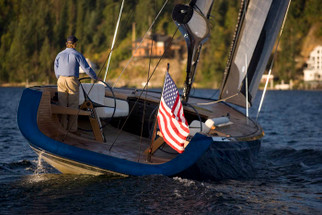Posted by Dave on Aug 17th 2022
Sticky steering
It's a few days past mid-summer, so ignore all the back to school flyers for a while longer and enjoy the beautiful aft end of the season with the return of breeze and fish, and relief from the worst of the punishing heat.
As often happens, we've recently had a run of questions on one topic. Lately, that question's been about sticky steering on older boats, though in several cases on older boats that have recently had some steering maintenance done on them.
The maintenance caveat is a great clue, as it usually lets us get to the problem straight away. When you replace your chain and wire, you need to be aware of balancing your chain on either side of the sprocket - to within a link or two if not exactly spot on. If you haven't got the chain centered, you'll run out of chain on one side, with the chain to wire transition bumping into the sprocket, while the other side will have the chain to wire transition potentially bottoming out against the cockpit sole and idler plate. Also pay careful attention to applying balanced turns to the cables when you tighten them, as putting tension on one side without matching it on the other side will pull the chain off center.
Steerer needle bearings generally last for a good couple of decades, but that presupposes regularly maintenance (hopefully twice yearly greasing) and generally non-extreme operating circumstances. Many of you reading this will have steering systems whose needle bearings are due (or long overdue) for a replacement. If your steering feels gritty, the first suspect is the needle bearings. This is definitely NOT one of those "turn the stereo up and the problem goes away" deals as rough needle bearings are usually rough because the cage that holds the needles is compromised. When that cage gives way, it can lock the steering up entirely (and often does). Replacing needle bearings takes a couple of hours, but getting home without steering could take a lot longer and is definitely more stressful.
We've banged on about worn sheave pins before, and they rear their heads again here. The pins are the axle on which the sheave turns. If they get worn, you've got an axle that's not round and round is definitely the best shape for axles! Another potential culprit at the sheave pins is the cotter pins that secure them in the sheave bases and idlers. If the ears that prevent the cotter pins from moving, and thus the pin from spinning, are broken, then the sheave might want to turn the axle into a spindle, and use the idler or sheave base as a bearing surface for that. Axles aren't supposed to spin, so make sure the sheave pins cotter pins are held in place by those ears.
Cable misalignment causes friction in the steering system. Adjustable idlers offer an easy fix to this problem, and most times a simple loosening and realignment of the idler will solve misalignment.
Maladjusted cables are the last big potential culprit here. Mostly loose cables will cause steering lag as a first-order thing, but eventually they will cause issues in other parts of the system. Overly tight cables cause steering to feel like it's got a lot of friction on it, and will then compound that by prematurely wearing out your needle bearings and sheave pins.
Boats are supposed to be a joy to steer, and solving less than joyful steering is within reach.

